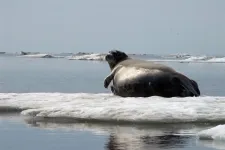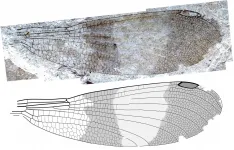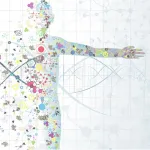Apollo rock samples capture key moments in the Moon's early history, study find
2021-02-24
(Press-News.org) PROVIDENCE, R.I. [Brown University] -- Volcanic rock samples collected during NASA's Apollo missions bear the isotopic signature of key events in the early evolution of the Moon, a new analysis found. Those events include the formation of the Moon's iron core, as well as the crystallization of the lunar magma ocean -- the sea of molten rock thought to have covered the Moon for around 100 million years after the it formed.
The analysis, published in the journal Science Advances, used a technique called secondary ion mass spectrometry (SIMS) to study volcanic glasses returned from the Apollo 15 and 17 missions, which are thought to represent some of the most primitive volcanic material on the Moon. The study looked specifically at sulfur isotope composition, which can reveal details about the chemical evolution of lavas from generation, transport and eruption.
"For many years it appeared as though the lunar basaltic rock samples analyzed had a very limited variation in sulfur isotope ratios," said Alberto Saal, a geology professor at Brown University and study co-author. "That would suggest that the interior of the Moon has a basically homogeneous sulfur isotopic composition. But using modern in situ analytical techniques, we show that the isotope ratios of the volcanic glasses actually have a fairly wide range, and those variations can be explained by events early in lunar history."
The sulfur signature of interest is the ratio of the "heavy" sulfur-34 isotope to the lighter sulfur-32. Initial studies of lunar volcanic samples found that they uniformly leaned toward the heavier sulfur-34. The nearly homogeneous sulfur isotope ratio was in contrast with large variations in other elements and isotopes detected in the lunar samples.
This new study looked at 67 individual volcanic glass samples and their melt inclusions -- tiny blobs of molten lava trapped within crystals inside the glass. Melt inclusions capture the lava before sulfur and other volatile elements are released as gas during eruption -- a process called degassing. As such, they offer a pristine picture of what the original source lava was like. Using the SIMS at the Carnegie Institution for Science, Saal with his colleague, the late Carnegie scientist Eric Hauri, were able to measure the sulfur isotopes in these pristine melt inclusions and glasses, and use those results to calibrate a model of the degassing process for all the samples.
"Once we know the degassing, then we can estimate back the original sulfur isotope composition of the sources that produced these lavas," Saal said.
Those calculations revealed that the lavas had been derived from different reservoirs within the interior of the Moon with a wide range of sulfur isotope ratios. The researchers then showed that the range of values detected in the samples could be explained by events in the Moon's early history.
The lighter isotope ratio in some of the volcanic glasses, for example, is consistent with the segregation of the iron core from the early molten Moon. When an iron core separates from other material in a planetary body, it takes a bit of sulfur with it. The sulfur that's taken tends to be the heavier sulfur-34 isotope, leaving the remaining magma enriched in the lighter sulfur-32.
"The values we see in some of the volcanic glasses are fully consistent with models of the core segregation process," Saal said.
The heavier isotope values can be explained by the further cooling and crystallization of the early molten Moon. The crystallization process removes sulfur from the magma pool, producing solid reservoirs with heavier sulfur-34. That process is the likely source of the heavier isotope values found in some of the volcanic glasses and basaltic rocks returned from the Moon.
"Our results suggest that these samples record these critical events in lunar history," Saal said. "As we keep looking at these samples with newer and better techniques, we keep learning new things."
More work needs to be done -- and more samples need to be analyzed -- to fully understand the sulfur isotopic composition of the Moon, Saal says. But these new results help to clarify long-standing questions about the composition of the Moon's interior, and they bring scientists one step closer to understanding the formation and early history of the Moon.
INFORMATION:
The research was funded by NASA's Solar System Workings program (80NSSC20K0461).
ELSE PRESS RELEASES FROM THIS DATE:
2021-02-24
While COVID-19-related lockdowns may have decreased the spread of a deadly virus, they appear to have created an ideal environment for increased domestic violence.c
Data collected in surveys of nearly 400 adults for 10 weeks beginning in April 2020 suggest that more services and communication are needed so that even front-line health and food bank workers, for example -- rather than only social workers, doctors and therapists -- can spot the signs and ask clients questions about potential intimate partner violence. They could then help lead victims to resources, said Clare Cannon, assistant professor of social and environmental justice in the Department of Human Ecology and the lead author of the study.
The paper, "COVID-19, intimate partner violence, and communication ...
2021-02-24
BOSTON - Swelling of lymph nodes in the armpit area is a normal response to COVID-19 vaccinations, but when they are seen on mammograms, they can be mistaken for nodes that are swollen because of cancer. In some cases, the nodes are biopsied to confirm they are not cancer. To avoid confusion by patients and their providers, and to avoid delays in either vaccinations or recommended mammograms through the pandemic, radiologists at Massachusetts General Hospital (MGH) have published an approach to manage what is expected to be a fairly common occurrence as vaccination programs ramp up. The approach is described in the American Journal of Roentgenology.
"We had started ...
2021-02-24
A new study from North Carolina State University reveals that the soundscapes of coral reef ecosystems can recover quickly from severe weather events such as hurricanes. The work also demonstrates that non-invasive monitoring is an important tool in shedding further light on these key ecosystems.
Soundscape ecology is a relatively new way for researchers to keep tabs on a variety of habitats without direct interference. In underwater habitats like coral reefs, soundscapes allow continual monitoring of an ecosystem that is difficult to access. By deploying underwater microphones, or hydrophones, researchers can get an acoustic picture of the types of animals in the ecosystem, as well as their behavior patterns.
Kayelyn Simmons, a Ph.D. student at NC State, used soundscapes and ...
2021-02-24
NASA's Parker Solar Probe captured stunning views of Venus during its close flyby of the planet in July 2020.
Though Parker Solar Probe's focus is the Sun, Venus plays a critical role in the mission: The spacecraft whips by Venus a total of seven times over the course of its seven-year mission, using the planet's gravity to bend the spacecraft's orbit. These Venus gravity assists allow Parker Solar Probe to fly closer and closer to the Sun on its mission to study the dynamics of the solar wind close to its source.
But -- along with the orbital dynamics -- these passes can also yield some unique and even unexpected views of the inner solar system. During the mission's third ...
2021-02-24
Evolutionary expert Charles Darwin and others recognized a close evolutionary relationship between humans, chimps and gorillas based on their shared anatomies, raising some big questions: how are humans related to other primates, and exactly how did early humans move around? Research by a Texas A&M University professor may provide some answers.
Thomas Cody Prang, assistant professor of anthropology, and colleagues examined the skeletal remains of Ardipithecus ramidus ("Ardi"), dated to 4.4 million years old and found in Ethiopia. One of Ardi's hands was exceptionally well-preserved.
The researchers compared the shape of Ardi's hand to hundreds of other hand specimens representing recent humans, apes and monkeys (measured ...
2021-02-24
A study co-authored by scientists at the New England Aquarium has found that known deaths of critically endangered North Atlantic right whales represent a fraction of the true death toll. This comes as the death of a calf and recent sightings of entangled right whales off the southeastern United States raise alarm.
The study, published this month in END ...
2021-02-24
Ithaca, NY-- During mating season, male bearded seals make loud calls to attract a mate--even their "quiet" call could still be as ear-rattling as a chainsaw. Bearded seals have to be loud to be heard over the cacophony of their equally loud brethren. And, increasingly, the noise humans make is adding to the underwater din and could have serious consequences. A study conducted by the Cornell Lab of Ornithology's Center for Conservation Bioacoustics (CCB) aims to understand how resilient bearded seals can be to changes in ambient underwater noise. The results are published in Proceedings of the Royal Society: Biological Science.
"We wanted to know whether bearded seals would call louder when ...
2021-02-24
Researchers at Stevens Institute of Technology have developed a new machine learning-powered platform, known as OC-SMART, that can process ocean color in satellite images 10 times faster than the world's leading platform. The work, which will be adopted by NASA, is one of the first machine learning-based platforms in ocean color analysis that can process both coastal and open ocean regions globally to reveal data on sea health and the impact of climate change.
The work, led by Knut Stamnes, a physics professor at Stevens, and spearheaded by Yongzhen Fan Ph.D. '16, a visiting physics scholar in Stamnes' lab, solves a 30-year-old problem in retrieving data from both coastal regions and open ocean areas. For decades, NASA's SeaDAS platform exceled at analyzing ocean color ...
2021-02-24
For more than 150 years, scientists have been incorrectly classifying a group of fossil insects as damselflies, the familiar cousins of dragonflies that flit around wetlands eating mosquitoes. While they are strikingly similar, these fossils have oddly shaped heads, which researchers have always attributed to distortion resulting from the fossilization process.
Now, however, a team of researchers led by Simon Fraser University (SFU) paleontologist Bruce Archibald has discovered they aren't damselflies at all, but represent a major new insect group closely related to them.
The findings, published today in Zootaxa, show that the distinctive shape of the insect's non-protruding, ...
2021-02-24
When people hear botulinum toxin, they often think one of two things: a cosmetic that makes frown lines disappear or a deadly poison.
But the "miracle poison," as it's also known, has been approved by the F.D.A. to treat a suite of maladies like chronic migraines, uncontrolled blinking, and certain muscle spasms. And now, a team of researchers from Harvard University and the Broad Institute have, for the first time, proved they could rapidly evolve the toxin in the laboratory to target a variety of different proteins, creating a suite of bespoke, super-selective ...
LAST 30 PRESS RELEASES:
[Press-News.org] Apollo rock samples capture key moments in the Moon's early history, study find




